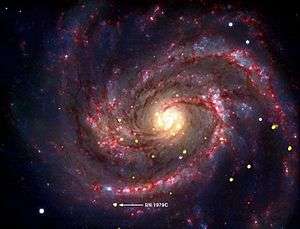SN 1979C
| SN 1979C | |
|---|---|
 | |
| Observation data (Epoch J2000.0) | |
| Supernova type | Type II [1] |
| Remnant type | ? |
| Host galaxy | M100 |
| Constellation | Coma Berenices |
| Right ascension | 12h 22m 58.58s |
| Declination | +15° 47′ 52.7″ |
| Galactic coordinates | G271.2454 +76.8848 |
| Discovery date | 1979 |
| Peak magnitude (V) | +12.23 |
| Distance | 50 Mly |
| Physical characteristics | |
| Progenitor | ? |
| Progenitor type | ? |
| Colour (B-V) | ? |
SN 1979C was a supernova about 50 million light-years away in Messier 100, a spiral galaxy in the constellation Coma Berenices. The Type II supernova was discovered April 19, 1979 by Gus Johnson, a school teacher and amateur astronomer.[2] This type of supernova is known as a core collapse and is the result of the internal collapse and violent explosion of a large star. A star must have at least 9 times the mass of the Sun in order to undergo this type of collapse.[3] The star that resulted in this supernova was estimated to be in the range of 20 solar masses.[1]
On November 15, 2010 NASA announced that evidence of a black hole had been detected as a remnant of the supernova explosion. Scientists led by Dr. Dan Patnaude from the Harvard–Smithsonian Center for Astrophysics in Cambridge, MA evaluated data gathered between 1995 and 2007 from several space based observatories. NASA's Chandra X-ray Observatory, the Swift Gamma-Ray Burst Mission, as well as the European Space Agency's XMM-Newton, and Germany's ROSAT all participated in the examination.[4]
The researchers observed a steady source of X-rays and determined that it was likely that this was material being fed into the object either from the supernova or a binary companion. However, an alternative explanation would be that the X-ray emissions could be from the pulsar wind nebula from a rapidly spinning pulsar, similar to the one in the center of the Crab Nebula.[4] These two ideas account for several types of known X-ray sources. In the case of black holes the material that falls into the black hole emits the X-rays and not the black hole itself. Gas is heated by the fall into the strong gravitational field.
SN 1979C has also been studied in the radio frequency spectrum. A light curve study was performed between 1985 and 1990 using the Very Large Array radio telescope in New Mexico.[5]
See also
References
- 1 2 Nancy Atkinson (November 15, 2010). "Has a Recent, Nearby Supernova Become a Baby Black Hole?". Universe Today. Retrieved 2010-11-18.
- ↑ Peter Edmonds (November 16, 2010). "The Man Who Discovered SN 1979C and Beat the Machines". Harvard–Smithsonian Center for Astrophysics. Retrieved 2010-11-21.
- ↑ Gilmore, Gerry (2004). "The Short Spectacular Life of a Superstar". Science. 304 (5697): 1915–1916. doi:10.1126/science.1100370. PMID 15218132. Retrieved 2007-05-01.
- 1 2 Trent Perrotto; Janet Anderson; Megan Watzke (Nov 15, 2010). "NASA'S Chandra Finds Youngest Nearby Black Hole". NASA. Retrieved 2010-11-15.
- ↑ Weiler, K. W.; van Dyk, S. D.; Discenna, J. L.; Panagia, N.; Sramek, R. A. (1991). "The 10 year radio light curves for SN 1979C". Astrophysical Journal. 380: 161–166. Bibcode:1991ApJ...380..161W. doi:10.1086/170571.

